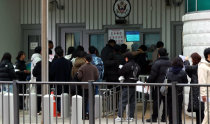Korea seen from The Hague
There is a joke in Europe saying heaven is where the British are the police, the French are the lovers, the Italians are the chefs, the Germans are the mechanics, and the Swiss make everything run on time. But hell is where the Germans are the police, the Swiss are the lovers, the British are the chefs, the French are the mechanics, and the Italians make everything run on time.
This is what I heard from a person in the Korean Embassy in the Netherlands, who added that everybody in Europe agrees with it. There is a joke on three Northeast Asian neighbors Korea, China, and Japan. A Korean, a Chinese, and a Japanese met an alien. The Chinese asked, Do you have history? The Japanese asked, Do you have manners? and then the Korean asked, Do you know Korea?
But a joke is a joke. But the joke gives a home thrust in The Hague, the Netherlands. This reporter covering President Park Geun-hye who attended the Nuclear Security Summit made time to visit the Yi Jun Peace Museum on Monday.
The museum is located in De Jong Hotel where Yi stayed during his stay in The Hague. The wooden floor on the second floor remains unchanged. The 140-year-old wooden floor was rotten and creaked. A 48-year-old man must have stayed up all night, walking on this floor and appealing about his country that nobody knew.
The Korean Empire, which lost its diplomatic rights in the 1905 Korea-Japan Eulsa Treaty, was a country only in name. After Yi Jun learned that representatives of 44 countries will gather to discuss world peace in the second World Peace Conference in The Hague in 1907, he headed for The Hague as a special envoy of King Gojong. In 65 days after leaving Seoul, he was treated poorly and even was not allowed to enter the place in The Hague. Although Cor´ee was there on the 12th of the invitation list, he could not enter the conference room due to Japans interference. When he complained about the unfair Eulsa treaty outside the conference room, Courrier de la Conference de la Paix covered Yi and his delegation under the title of The Skeleton of Party.
On the 19th day of his arrival in The Hague, Yi Jun died at a hotel. It remains unknown what caused his death. Song Chang-joo, the head of the museum, says it is clear that he did not die of a disease. He was unlucky even after death. After 53 days from his death, he was buried in a nearby cemetery run by the city after Yi Sang-sul, his companion, paid 102.75 dollars. His body finally returned home in 56 years in October 1963.
Song seemed emotional, saying this Nuclear Security Summit is the third International Peace Conference. Although the emperors envoy became a skeleton outside the meeting room, Korean President Park Geun-hye made opening remarks at the third International Peace Conference after 107 years from his death.
The heads of state of Korea and Japan met on Wednesday morning (Korea Time) in the place where the patriots spirit lingers. The historic meeting was rather saddening me touching. A century has passed but Japan did not change a bit. Korea is divided into two. Yi still asks, Do you know the reality of Korea? Is there peace?
From The Hague



![라면 5만 개 끓여 보며 성능 테스트… “무인점 라면 조리기 95% 차지”[유레카 모멘트]](https://dimg.donga.com/c/138/175/90/1/wps/NEWS/IMAGE/2025/12/27/133042718.4.jpg)

![스페인·남아공 떴는데, 사우디·태국은 왜…2025년 경제 결산[딥다이브]](https://dimg.donga.com/c/138/175/90/1/wps/NEWS/IMAGE/2025/12/26/133039499.1.jpg)

